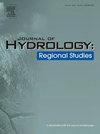Evaluation of national and international gridded meteorological products for rainfall-runoff modelling in Northern Italy
IF 4.7
2区 地球科学
Q1 WATER RESOURCES
引用次数: 0
Abstract
Study region
Northern Italy.
Study focus
Gridded meteorological products provide spatially-distributed meteorological forcings, facilitating hydrological modeling in large-scale experiments. However, their accuracy, in particular as far as precipitation is concerned, varies considerably in space and time, and rigorous validation of these products is essential before their application. This study conducts a large-scale evaluation of five meteorological datasets in Northern Italy through i) a direct comparison of precipitation and temperature estimates and ii) an indirect validation, assessing their ability to reproduce streamflow when used to force the CemaNeige-GR6J hydrological model. The tested datasets include two gauged-based products, namely SCIA (the reference gridded dataset from the Italian Institute for Environmental Protection and Research) and E-OBS, two products based on reanalyses (the global ERA5-Land and the national MERIDA) and a gauged-corrected global satellite precipitation product (CHIRPS).
New hydrological insights for the region
Gauge-based datasets provide the best streamflow simulations when the underlying station density is high: SCIA, based on a uniform and dense gauge network across the entire study area, confirms to be the best choice as the climatic reference dataset, while the use of E-OBS is not recommended in Piedmont due to the low number of stations. In areas with low station density, reanalyses may yield to more accurate results: among reanalysis-based products, the Italian MERIDA dataset outperforms ERA5-Land. Finally, CHIRPS results to be the least accurate precipitation dataset.
评估用于意大利北部降雨-径流建模的国家和国际网格气象产品
研究地区意大利北部。研究重点网格气象产品提供了空间分布的气象诱因,有助于大规模实验中的水文建模。然而,这些产品的准确性,尤其是降水的准确性,在空间和时间上存在很大差异,因此在应用之前必须对这些产品进行严格验证。本研究对意大利北部的五个气象数据集进行了大规模评估,包括 i) 降水量和温度估算值的直接比较;ii) 间接验证,评估这些数据集用于强制 CemaNeige-GR6J 水文模型时再现溪流的能力。测试的数据集包括两个基于测量的产品,即 SCIA(意大利环境保护与研究所的参考网格数据集)和 E-OBS,两个基于再分析的产品(全球 ERA5-Land 和国家 MERIDA)以及一个经过测量校正的全球卫星降水产品(CHIRPS):SCIA 基于整个研究区域统一而密集的测站网络,被证实是气候参考数据集的最佳选择,而在皮埃蒙特,由于测站数量较少,不建议使用 E-OBS。在站点密度较低的地区,再分析可能会产生更准确的结果:在基于再分析的产品中,意大利 MERIDA 数据集的性能优于 ERA5-Land。最后,CHIRPS 是最不准确的降水数据集。
本文章由计算机程序翻译,如有差异,请以英文原文为准。
求助全文
约1分钟内获得全文
求助全文
来源期刊

Journal of Hydrology-Regional Studies
Earth and Planetary Sciences-Earth and Planetary Sciences (miscellaneous)
CiteScore
6.70
自引率
8.50%
发文量
284
审稿时长
60 days
期刊介绍:
Journal of Hydrology: Regional Studies publishes original research papers enhancing the science of hydrology and aiming at region-specific problems, past and future conditions, analysis, review and solutions. The journal particularly welcomes research papers that deliver new insights into region-specific hydrological processes and responses to changing conditions, as well as contributions that incorporate interdisciplinarity and translational science.
 求助内容:
求助内容: 应助结果提醒方式:
应助结果提醒方式:


